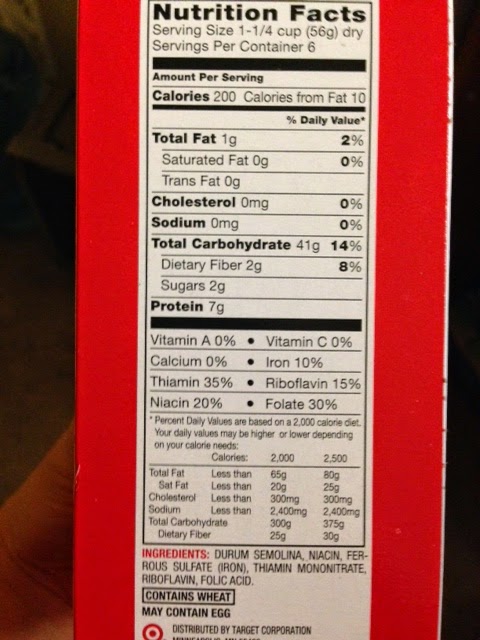When you're eating healthy and exercising, the last thing you want to do is hurt your progress by eating something that's not good for you. But, labels can be tricky to read and understand, so how do you differentiate between the good, the bad, and the ugly?
Let's go over a few basic things about label reading.
1. The majority of your food should not have a nutrition label at all. Think about it. Your main food sources should be fresh fruits and veggies, lean protein, and healthy fats. When was the last time you saw a nutrition label or ingredients list on a bunch of bananas or a chicken breast?
2. Look for foods with 5 or fewer ingredients. If you do eat something with a label, make sure the ingredients are REAL food, not chemical food-like substances. You want to be able to pronounce all the ingredients and know what they are.
3. Avoid buzz words. Foods labeled "all natural" or "healthy" aren't necessarily good choices. Instead, look for organic ingredients and non-GMO foods.
4. Avoid added sugars. This goes for artificial sugars as well, and yes I include stevia in my non-approved list. As far as I'm concerned, for a healthy diet, refined sugars are a no-no. And, sugar substitutes like stevia, sucralose, aspartame, splenda, equal, etc are way worse than even regular table sugar. My only approved sweeteners are organic coconut sugar, raw honey, or real maple syrup (not the processed kind that's not pure from nature).
5. Don't worry about the calories and fat. Unless you have a specific caloric or fat need as prescribed by your doctor, don't even pay attention to that part of the label. If you mainly eat real, whole foods, you don't have to worry about counting calories and fat. The quality of your food is of the utmost importance.
So, looking at these 3 labels, which one is the good? Which is the bad? And which is the ugly?
 |
THE GOOD
This is a jar of almond butter. Check out the ingredients. There's only ONE ingredient and it's Non-GMO almonds! The only way that ingredient list could be better is if they were organic. But, at least you know they're not GMO franken-food almonds. |
 |
The BAD
This is a box of pasta. Durum Semolina is a highly processed and very high in gluten (but low in nutrients) type of pasta. Niacin (also known as Vitamin B3) is added in to try and make up for the lack of nutrition. Ferrous Sulfate is Iron, which again is added in to try and mask the lack of nutrition. Thiamine Mononitrate is a synthetic form of the naturally occurring B1 vitamin. The reason this is significant is that this synthetic form is fat-soluble, which means your body has a harder time expelling any excess. Riboflavin (Vitamin B2) and Folic Acid are also added in this particular pasta. Why would you want to buy a product that was stripped of it's naturally occurring nutrients only to have these particular vitamins added back in? |
 |
The UGLY
This is a bottle of coffee creamer. The first ingredient tells you which ingredient is in the highest amount. So, there's a lot of water in this creamer. Next you have sugar. Regular, white, unhealthy table sugar. And, it's in a large amount since it's the 2nd ingredient. Vegetable oil is next. Run away now! Vegetable oil is made from soybeans. Soybeans are the top GMO crop. Plus, soy has a number of unhealthy side effects. It's a goitrogen as well as a form of phytoestrogen. Run away now! And, to top it all off, it's partially hydrogenated. Those words mean it contains trans fat, which is the most unhealthy kind of fat. Any time you see "hydrogenated oils" or "partially hydrogenated oils" those are major red flags. Sodium Caseinate (sometimes labeled Casein) is a milk derivative. It's a tricky way for companies to label hidden milk products in your foods without you knowing it. So, even though this is a "non-dairy creamer," it actually contains dairy. This can be a big problem for people with allergies or milk sensitivities. Mono and Diglycerides are food additives that are there to extend shelf life. That means they add in chemicals (these happen to contain trans fat) to make the "food" last longer than it should. Sounds appetizing right? Dipotassium Phosphate is a highly water-soluble salt used to prevent coagulation. But, it's also commonly used in fertilizer. Cellulose gel is a thickening agent used to thicken foods without adding calories. But, it's made from wood pulp. Yep, you read that right. Salt is the next ingredient, because we didn't get enough sodium already with the dipotassium phosphate. Natural and Artificial Flavors is basically a code word for "anything and everything under the sun." It can even include things like castoreum, which is the secretions from a beaver's anal glands. Yep, you read that right too. Cellulose gum is there to prevent sugar from crystallizing, and it's from that good old wood pulp again. Sucralose is an artificial sweetener which is not good for you by any means. And, by the way, this product already contains sugar, so why does it need more sweetener? Finally, we have carrageenen. Carrageenen is a thickening agent with no nutritional value. It's derived from red edible seaweeds. The problem is that it's extremely bad for your digestive system and causes inflammation, and has even been linked to gastrointestinal cancers in lab animals. Does this coffee creamer sound appetizing to you now?
The takeaway from all of this should be that you need to know what's in your food. Don't fall prey to the buzzwords and advertising on the front of the box. Read your labels, know your ingredients, and buy REAL FOOD!
|



No comments:
Post a Comment